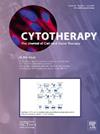使用 qPCR 和 ddPCR 研究细胞疗法产品的生物分布:多站点评估。
IF 3.2
3区 医学
Q2 BIOTECHNOLOGY & APPLIED MICROBIOLOGY
引用次数: 0
摘要
背景目的:采用细胞治疗产品(CTPs)的再生疗法已引起广泛关注。对 CTPs 进行生物分布 (BD) 评估主要是为了明确细胞的存活时间、移植和分布部位。这项评估对于根据非临床生物分布研究结果预测临床研究的疗效和安全性至关重要。然而,目前还没有国际统一的方法来评估给药后的细胞 BD。在此,我们旨在将用于CTPs的BD检测方法标准化,在多个研究机构中使用相同的方案进行以下评估:(1)使用灵长类特异性Alu基因对定量聚合酶链反应(qPCR)和液滴数字PCR(ddPCR)分析进行体外验证;(2)对免疫缺陷小鼠静脉注射人间质干细胞(hMSCs)后进行体内BD研究,这通常用于非临床致瘤性研究:方法:通过在几种小鼠组织中加入固定数量的人源细胞,制备和分析质量控制样本。给免疫缺陷小鼠静脉注射 hMSCs,并在给药后 1、4 和 24 小时收集组织:结果:两种方法的准确度(相对误差)一般都在±50%以内,精确度(变异系数)一般都低于50%。虽然 qPCR 和 ddPCR 在校准曲线范围上存在差异,但两种检测方法在定量方面没有发现显著差异。七家机构对小鼠体内 hMSCs 的 BD 进行了评估(三家机构进行了 qPCR 分析;四家机构进行了 ddPCR 分析),结果显示所有机构的组织分布情况相似,其中肺部在所测试的组织中细胞分布最多:结论:使用 Alu 序列对 qPCR 和 ddPCR 进行了定量评估,表明该测试方法可用于 BD 评估。本文章由计算机程序翻译,如有差异,请以英文原文为准。
Using qPCR and ddPCR to study biodistribution of cell therapy products: a multi-site evaluation
Backgroud aims
Regenerative therapies employing cell therapy products (CTPs) have attracted considerable attention. Biodistribution (BD) evaluation of CTPs is mainly performed to clarify the cell survival time, engraftment, and distribution site. This evaluation is crucial for predicting the efficacy and safety profiles of clinical studies based on non-clinical BD study outcomes. However, no internationally unified method has been established for assessing cell BD after administration. Here, we aimed to standardize the BD assay method used for CTPs, conducting the following evaluations using the same protocol across multiple study facilities: (1) in vitro validation of quantitative polymerase chain reaction (qPCR) and droplet digital PCR (ddPCR) analyses using the primate-specific Alu gene, and (2) in vivo BD studies after the intravenous administration of human mesenchymal stem cells (hMSCs) to immunodeficient mice, commonly used in non-clinical tumorigenicity studies.
Methods
Quality control samples were prepared and analyzed by adding a fixed number of human-derived cells to several mouse tissues. The respective quantitative performances of the qPCR and ddPCR methods were compared for accuracy and precision. hMSCs were intravenously administered to immunodeficient mice, and tissues were collected at 1, 4, and 24 h after administration.
Results
Both methods demonstrated an accuracy (relative error) generally within ±50% and a precision (coefficient of variation) generally less than 50%. While differences in calibration curve ranges were observed between qPCR and ddPCR, no significant differences in quantification were found among the assay facilities. The BD of hMSCs in mice was evaluated at seven facilities (qPCR at three facilities; ddPCR at four facilities), revealing similar tissue distribution profiles in all facilities, with the lungs showing the highest cell distribution among the tissues tested.
Conclusions
Quantitative evaluation of qPCR and ddPCR using Alu sequences was conducted, demonstrating that the test method can be adapted for BD evaluation.
求助全文
通过发布文献求助,成功后即可免费获取论文全文。
去求助
来源期刊

Cytotherapy
医学-生物工程与应用微生物
CiteScore
6.30
自引率
4.40%
发文量
683
审稿时长
49 days
期刊介绍:
The journal brings readers the latest developments in the fast moving field of cellular therapy in man. This includes cell therapy for cancer, immune disorders, inherited diseases, tissue repair and regenerative medicine. The journal covers the science, translational development and treatment with variety of cell types including hematopoietic stem cells, immune cells (dendritic cells, NK, cells, T cells, antigen presenting cells) mesenchymal stromal cells, adipose cells, nerve, muscle, vascular and endothelial cells, and induced pluripotential stem cells. We also welcome manuscripts on subcellular derivatives such as exosomes. A specific focus is on translational research that brings cell therapy to the clinic. Cytotherapy publishes original papers, reviews, position papers editorials, commentaries and letters to the editor. We welcome "Protocols in Cytotherapy" bringing standard operating procedure for production specific cell types for clinical use within the reach of the readership.
 求助内容:
求助内容: 应助结果提醒方式:
应助结果提醒方式:


